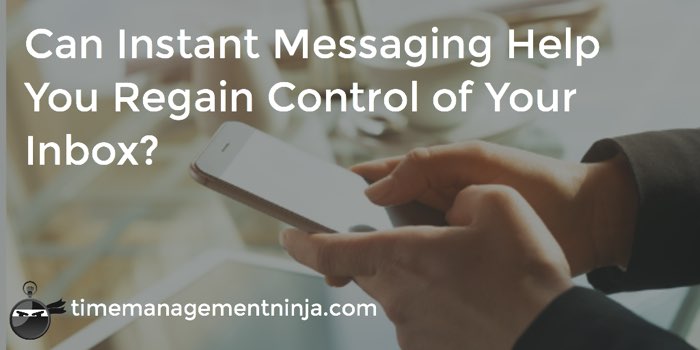Instant messaging (IM) has suffered unfairly over the last 20 years, afflicted with a rocky reputation as a social media platform for gossiping teenagers and bored university students. Its abilities as a powerful enterprise collaboration tool have largely been underestimated, with email owning the workplace.
IM has been particularly pigeonholed in the US, where some 70% of teenagers already send more instant messages than emails. With that kind of engrained loyalty, it could be set for a resurgence in the workplace in the near future and could even overtake email as the dominant communication tool.
Instant Messaging Versus Email
Being a free-to-use and an immediate real-time platform, but being unable to store conversation trails, IM has both advantages and disadvantages over email – not least in security and bandwidth usage. IM doesn’t store conversation trails in the same way but now more companies are investigating it as a possible support to email and video conferencing or even to replace them completely.
Most of us have inboxes that are almost always full and contain several hours of work to sort each day. In fact it has been estimated that handling emails for an average of 30 minutes each day could cost businesses the equivalent of two weeks’ pay.
Instant messaging allows the creation of private chat rooms where a group of colleagues can discuss a project or an issue, rather than bouncing around email chains where roles and responsibilities can get lost.
More platforms are looking towards business and Skype, now owned by Microsoft, is busily re-pitching itself to the business sector. There are already plenty of less well-known IM applications with excellent functionality for business purposes, particularly Slack, which is enjoying a significant growth in popularity.
Instant Messaging: The Next Thing in Business
Instant messaging can be a fantastic way to easily collaborate with multiple people on one project, avoiding lengthy email chains, whether it’s a web designer in Texas or an editorial contributor in Tokyo. They can immediately provide feed back on topics and contribute to discussions. It also helps avoid the confusion over roles and responsibilities that can happen with lengthy email chains.
It is clear that both IM and email have their place in office communications, depending on the needs of the business. Combining the strengths of the two may be the way forward. Email provides a clear trail and a static base from which to work whereas IM provides clean, quick discussions in a more collaborative format.
For immediate project work or for updates, instant messaging could work much better, providing a quick response to questions and clearing out many unnecessary emails from your inbox.
Question: Has your business started using instant messaging in the workplace? How could it change the way you do business? You can leave a comment by clicking here.
 I am the author of Time Management Ninja and help individuals and companies reclaim their time to be more productive. As well, I am the author of the book
I am the author of Time Management Ninja and help individuals and companies reclaim their time to be more productive. As well, I am the author of the book 

Yes, our business has startet to use IM. And I don’t see the problem of not storing conversation trails, my IM systems (Lync communicator on the corporate side and XMPP on the private side of life) allow me to retriev conversation trails from the server.
IM will not be a replacement for email because the usual IM communication is one-to-one (as a telephone call) and not one-to-many or many-to-many while corporate email us usually one-to-many.
IM has an advantage over the telephone, that is the status indicator. Your communication partner can see if you’re available or not and can spare himself a call that is ending up on the answering machine. The problem is, that if he doesn’t respect that status indicator the IM message will popup on your screen even if you flagged yourself as “do not disturb”. So IM is not less disruptive as a telephone.
The other advantage over the telephone is that it makes it easier to communicate with people that have a terrible accent when they use a language that is not their native one. We notice that especially when communicating with people in Asia.
The disadvantage of IM compared with the telephone is, that people usually talk faster than they type on a keyboard. So an IM chat may take longer than a telephone call. This also has another bad impact. When talking to someone on the phone then this phone call usally has my focus and I concentrate on the talk. But what happens when you have an IM chat with person and that tiny little chat window on your big computer screen tells you “X is still typing”? You will lose focus after a few seconds and look at your webbrowser, email or whatever window is open on your screen. So you start to do multitasking until the next message from your communication partner arrives. Extremely bad for a productive conversation because you focus gets lost frequently.
Of course IM can be a great tool when you know the traps that are waiting for you and you try to avoid them. I remember a global software test sessions where developers were available on IM to answer questions from the test crew immediately, and yes, that day everybody was feeling very much productive.
But the risk is still, that IM just opens another channel of “noise” to your inbox. So it needs to be used carefully.
Similar here, conversation trails work perfectly and status indicators rock. In fact, I often start IM communications with several parties at once (one ‘room’), both for working groups (e.g. during project implementations) and screen sharing (e.g. when doing status updates, collaborating on a document). Works like a charm.
If there’s anything I dislike… Similar to e-mail, notifications can be a significant distraction. They simply add to everyday noise.
Hi Lech, Thanks for your comment. And I can’t help but agree
more, nothing more frustrating than an email notification popping up when you
are trying to get stuck in to some work. I simply turn notifications off most
of the time and sometimes put my out of office on so people don’t think I am
ignoring them.
It may work within organisations but when you are are freelance etc it is awkward as everyone uses different apps and you cannot cross over. I.e. You cannot send IM from Skype to someone on What’s App.
Thanks for sharing @Craig.
We’re undergoing a massive shift in how voice + messaging + email interplays together, both in consumer experience as well as in business.
IM/chat can add more noise and may actually get noisier/chattier than email itself. But it does give you far more control on what you you want to listen to, and it’s mostly opt-in, unlike email. Yet, it’s ironic how many chat systems fall over to email for their basic notification levels.
Email is ubiquitous, but impossible to take back once it’s gone out. Alternatively, IM/chat are usually centralised and the archive history can be very useful.
Yet, ephemeral conversations like a phone call or water cooler chit chat sometimes deliver the message in the most efficient way. Perhaps this is why SnapChat has struck a cord with Gen-Y and younger folks, because they rarely make phone calls, but don’t want everything conversation stored forever.
Then you’ve got true peer-to-peer systems which offer the highest level of control and security, but sometimes a challenging user experience and market adoption.
I believe a balanced approach will work if it combines multiple channels as long as the conversation context remains and users have a sense of control and the right experience. Actually that’s what we’re building today at my startup.